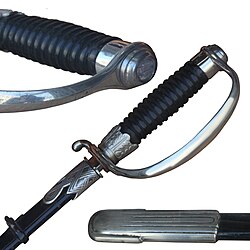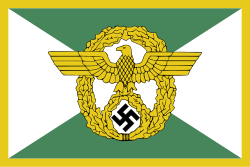Carl Oberg
| Carl Oberg | |
|---|---|
| Narození | 27. ledna 1897 |
| Úmrtí | 3. června 1965 (ve věku 68 let) |
| Vojenská kariéra | |
| Hodnost | SS-Obergruppenführer und General der Waffen-SS und Polizei |
| Složka | |
| Jednotka | Feldartillerie Regiment Nr. 24 Feldartillerie Regiment Nr. 45 |
| Velel | Vyšší šéf SS a Policie ve Francii |
| Války | První světová válka Druhá světová válka |
| Vyznamenání | Železný kříž I. třídy Železný kříž II. třídy |
Carl Albrecht Oberg (27. ledna 1897, Hamburk – 3. června 1965, Flensburg) byl německý válečný zločinec a důstojník Waffen-SS a policie v hodnosti SS-Obergruppenführer und General der Waffen-SS und Polizei během druhé světové války. Nechvalně proslulým se stal díky svému působení jako vyšší šéf SS a policie ve Francii.[1]
Mládí a první světová válka
Carl Oberg se narodil 27. ledna roku 1897 v Hamburku jako syn profesora medicíny. Po dokončení vzdělání a získání maturity vstoupil v srpnu roku 1914 do armády, kde byl zařazen v hodnosti Fähnrich (praporčík) ke 24. pluku polního dělostřelectva (Feldartillerie Regiment Nr. 24). Zde sloužil až do srpna následujícího roku.
Jeho dalším postem se stal 45. pluk polního dělostřelectva (Feldartillerie Regiment Nr. 45), kde sloužil až do konce války. Válku ukončil v hodnosti Leutnant (poručík) a získal oba stupně Železného kříže.
Poté, co bylo po prohrané válce Německo nuceno zredukovat svou armádu, vstoupil Carl Oberg do řad jednotek Freikorps a účastnil se také Kappova puče v roce 1920.
V letech 1942 až 1944 velel Oberg německým policejním jednotkám ve Francii (včetně SD a gestapa), které poté převzal plukovník SS Helmut Knochen. Oberg ve Francii vedl protižidovské akce a boj proti hnutí odporu.
Byl také zodpovědný za „konečné řešení židovské otázky ve Francii“. Tato akce vyústila v deportaci 75 000 Židů do vyhlazovacích táborů v Německu a Polsku.[2]
V roce 1945 byl zadržen americkými vojáky v jedné tyrolské vesnici. V roce 1946 byl nejprve ve Wuppertalu odsouzen k trestu smrti. Poté byl předán do Francie, kde byl za válečné zločiny 9. října 1954 odsouzen ke stejnému trestu. V roce 1958 mu byl trest změněn na doživotí. 28. listopadu 1962 byl Carl Oberg společně s Helmutem Knochenem po amnestii prezidenta de Gaulla propuštěn na svobodu. Poté až do své smrti žil ve Flensburgu.
Shrnutí vojenské kariéry
Data povýšení
- Fähnrich
- Leutnant – listopad, 1915
- SS-Sturmführer – 1. červenec, 1933
 SS-Obersturmführer – 25. září, 1933
SS-Obersturmführer – 25. září, 1933 SS-Hauptsturmführer – 7. březen, 1934
SS-Hauptsturmführer – 7. březen, 1934 SS-Sturmbannführer – 15. červen, 1934
SS-Sturmbannführer – 15. červen, 1934 SS-Obersturmbannführer – 4. červenec, 1934
SS-Obersturmbannführer – 4. červenec, 1934 SS-Standartenführer – 20. duben, 1935
SS-Standartenführer – 20. duben, 1935 SS-Oberführer – 20. duben, 1939
SS-Oberführer – 20. duben, 1939- Generalmajor der Polizei – 31. březen, 1942
 SS-Brigadeführer – 20. duben, 1942
SS-Brigadeführer – 20. duben, 1942 SS-Gruppenführer und Generalleutnant der Polizei – 20. duben, 1943
SS-Gruppenführer und Generalleutnant der Polizei – 20. duben, 1943 SS-Obergruppenführer und General der Polizei – 1. srpen, 1944
SS-Obergruppenführer und General der Polizei – 1. srpen, 1944- General der Waffen-SS – 10. březen, 1945
Významná vyznamenání
 Pruský železný kříž I. třídy (první světová válka)
Pruský železný kříž I. třídy (první světová válka) Pruský železný kříž II. třídy (první světová válka)
Pruský železný kříž II. třídy (první světová válka) Hamburský hanzovní kříž (první světová válka)
Hamburský hanzovní kříž (první světová válka) Válečný záslužný kříž I. třídy s meči
Válečný záslužný kříž I. třídy s meči Válečný záslužný kříž II. třídy s meči
Válečný záslužný kříž II. třídy s meči Kříž cti s meči
Kříž cti s meči Čestný prýmek starého bojovníka
Čestný prýmek starého bojovníka Čestná dýka Reichsführera-SS
Čestná dýka Reichsführera-SS Totenkopfring
Totenkopfring
- Listopad 1935 – leden 1937. SS-Standartenführer 22. SS-Standarte, "Mecklenburg", Schwerin[3]
- leden 1937 – prosinec 1938. SS-Standartenführer a Stabsführer SS-Abschnitt IV, Hannover.[4]
- ?? (nejpozději květen 1942) – duben 1943. SS-Brigadeführer a Generalmajor der Polizei[5]
- listopad 1939 – srpen 1941. SSPF "Radom"[6]
- květen 1942 – listopad 1944. HSSPF "Frankreich"[5]
Odkazy
Poznámka
Další varianty psaní jména v literatuře jsou (částečně je také sám používal): Karl Albrecht Oberg, Carl-Albrecht Oberg, Karl Oberg.
Literatura
- Ulrich Lappenküper Der "Schlächter von Paris". Carl-Albrecht Oberg als Höherer SS- und Polizeiführer in Frankreich (1942–1944) in: Deutschland und Frankreich im Krieg (Nov. 1942 – Herbst 1944). Okkupation, Kollaboration, Résistance Hg. S. Martens, M. Vaisse, Bonn: Bouvier, 2000 (s 129-143)
- Die faschistische Okkupationspolitik in Frankreich (1940–1944) Dokumentenauswahl. Hg. und Einl. Ludwig Nestler. Berlin: Deutscher Verlag der Wissenschaften, 1990 (Orts-, Personenregister) ISBN 3-326-00297-1 (zahlreiche Einträge im Index)
- Hermann Weiß (Hrsg.): Biographisches Lexikon zum Dritten Reich, Frankfurt 2002 ISBN 3-596-13086-7
Reference
- ↑ Ruth Bettina Birn: Die Höheren SS- und Polizeiführer. Himmlers Vertreter im Reich und in den besetzten Gebieten., Düsseldorf 1986, S.341
- ↑ Simkin, John. Carl Oberg: Nazi Germany [online]. [cit. 2009-02-20]. (Spartacus Educational Website). Dostupné v archivu pořízeném dne 2008-09-16.
- ↑ Yerger, Mark C. Allgemeine-SS. Atglen, PA: Schiffer Publishing, 1997.
- ↑ Yerger, p 123-124
- ↑ a b Yerger, p 51
- ↑ Yerger, p 55
Externí odkazy
 Obrázky, zvuky či videa k tématu Carl Oberg na Wikimedia Commons
Obrázky, zvuky či videa k tématu Carl Oberg na Wikimedia Commons
Média použitá na této stránce
Flag of the Germans(1866-1871)
Flag of the Germans(1866-1871)
Autor: Mintz l, Licence: CC BY-SA 3.0
Rank insignia of the SS/Waffen-SS, here universal collar patches to the CO-rank “SS-Standartenfuehrer” .
Autor: Mintz l, Licence: CC BY-SA 3.0
Rang insignia of the SS/Waffen-SS, here universal collar patches for officer rank “SS-Oberfuehrer”.
Autor: Mintz l, Licence: CC BY-SA 3.0
Rang insignia of the SS/Waffen-SS, here universal collar patches of “SS-Brigadefuehrer”.
Rang insignia of the SS/Waffen-SS, here universal collar patches to the General’s rank “SS-Gruppenfuehrer” until 1945.
Ribbon bar: Iron Cross 2nd Class (1813)-1914-1918 (Prussia) and Golden Military Merit Cross 1864-1918 (Prussia).
Ribbon bar: German (3rd Reich) War Merit Cross with Swords 1st Class.
Ribbon bar: German (3rd Reich) War Merit Cross with Swords 2nd Class.
Autor: Rama, Licence: CC BY-SA 2.0 fr
Weapons of honour of t he Third Reich until 1945, here “Honorary-dagger of the SS” with handle and scabbard.
Autor: Mintz l, Licence: CC BY-SA 3.0
Rang insignia of the SS/Waffen-SS, here universal collar patches to the General’s rank “SS-Obergruppenfuehrer” until 1945.
Rank insignia of the Waffen-SS to tress articles with shoulder boards (jacked service uniform, until 1945); here cuff insignia (left upper arm), single chevron to the rank:
- SS-Sturmmann, today NATO OR-2 comparable.
Autor: Rama, Licence: CC BY-SA 2.0 fr
Rank insignia of the SS/Waffen-SS, here universal collar patches to the CO-rank “SS-Sturmbannfuehrer” until 1945.
Autor: SysMusDes, Licence: CC BY-SA 3.0
Hanseatic Cross from Hamburg ribbon bar
Flag of the Ordnungspolizei (Orpo), "order police" or "the green police" in Nazi Germany 1936–1945; Command flag of the Chief of the Order Police; Flag with a wreathed golden "police eagle" (Polizeiadler), the police version of the "eagle-and-swastika" of the Nazi Party and the Third Reich.
Flag of the Nazi Ordnungspolizei (Orpo) "Order Police", the name for the uniformed regular German police force in existence during the period of Nazi Germany 1936–1945. Based on image at [1] and the [Image:Ordnungspolizei_Flag.jpg] on wikipedia
Autor: Rama, Licence: CC BY-SA 2.0 fr
Rang insignia of the SS/Waffen-SS, here universal collar patches to the CO-rank “SS-Obersturmbannfuehrer” until 1945.
Ribbon bar: Iron Cross - 1st Class (1813)-1914-1918 (Prussia).
Autor: Mintz l, Licence: CC BY-SA 3.0
Rang insignia of the SS/Waffen-SS, here universal collar patches to the CO-rank “SS-Obersturmfuehrer” until 1945.
Autor: Rama, Licence: CC BY-SA 2.0 fr
Rang insignia of the SS/Waffen-SS, here universal collar patches to the CO-rank “SS-Obersturmfuehrer” until 1945.
(c) Bundesarchiv, Bild 183-H25719 / CC-BY-SA 3.0
Carl Oberg, on 1 May 1943 in Paris.
Ribbon bar: "Honour Cross of the World War 1914/1918" (German Reich, 3 classes), here - for front-line veterans with swords.
























